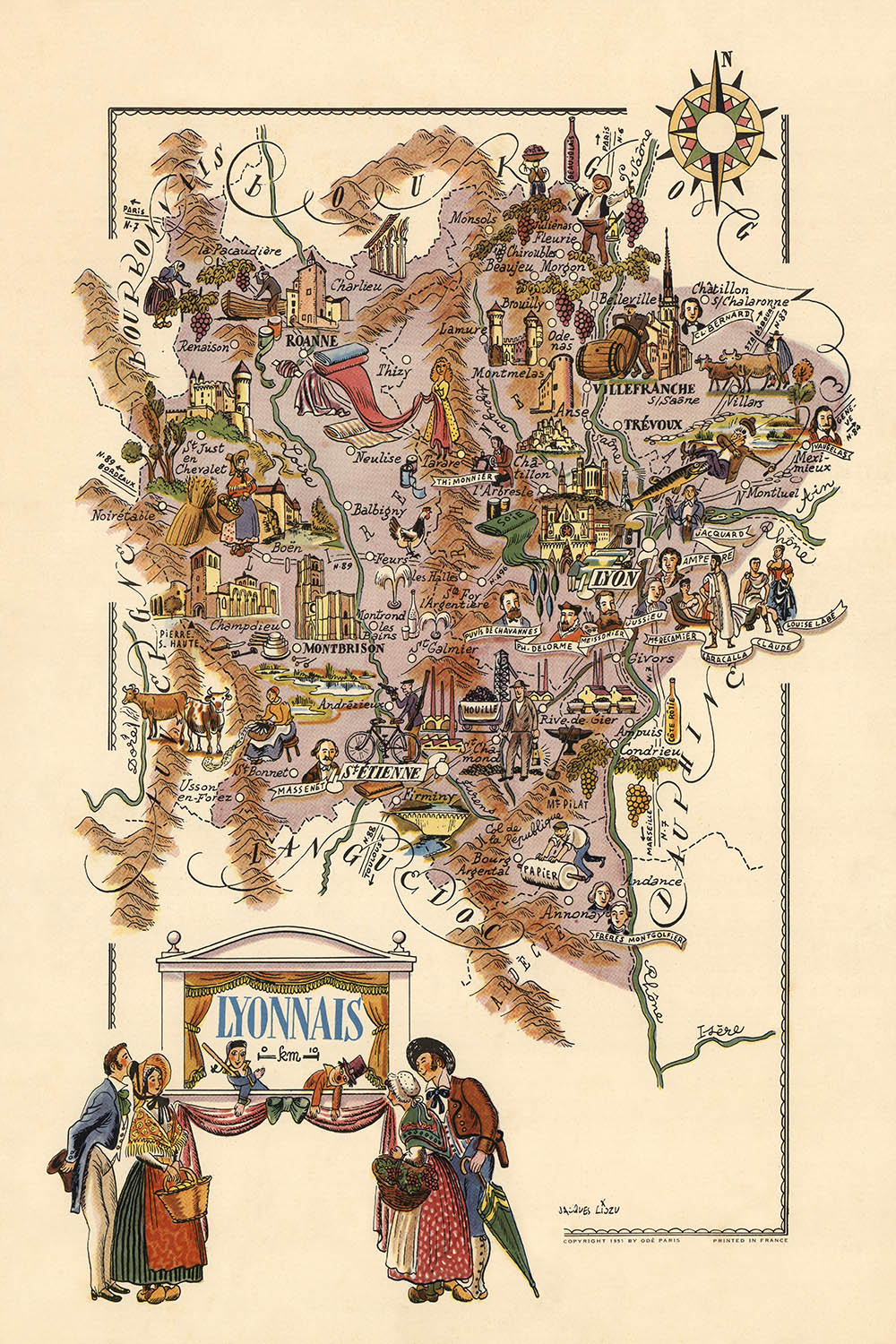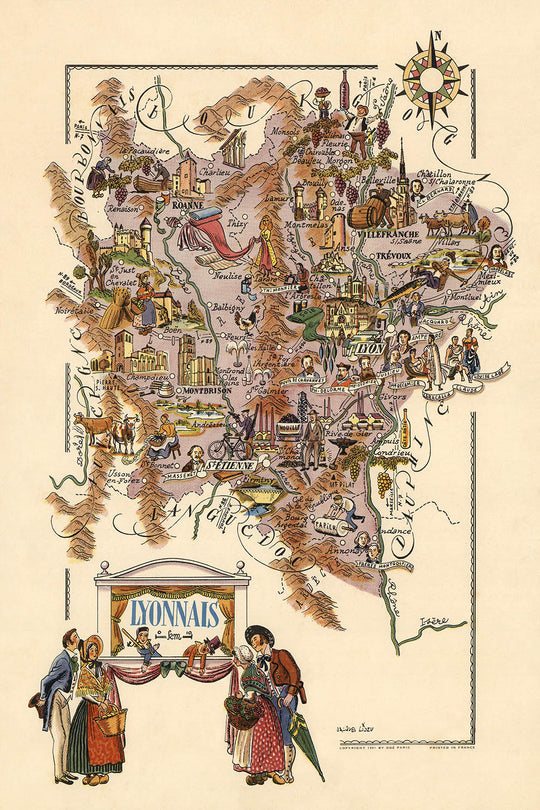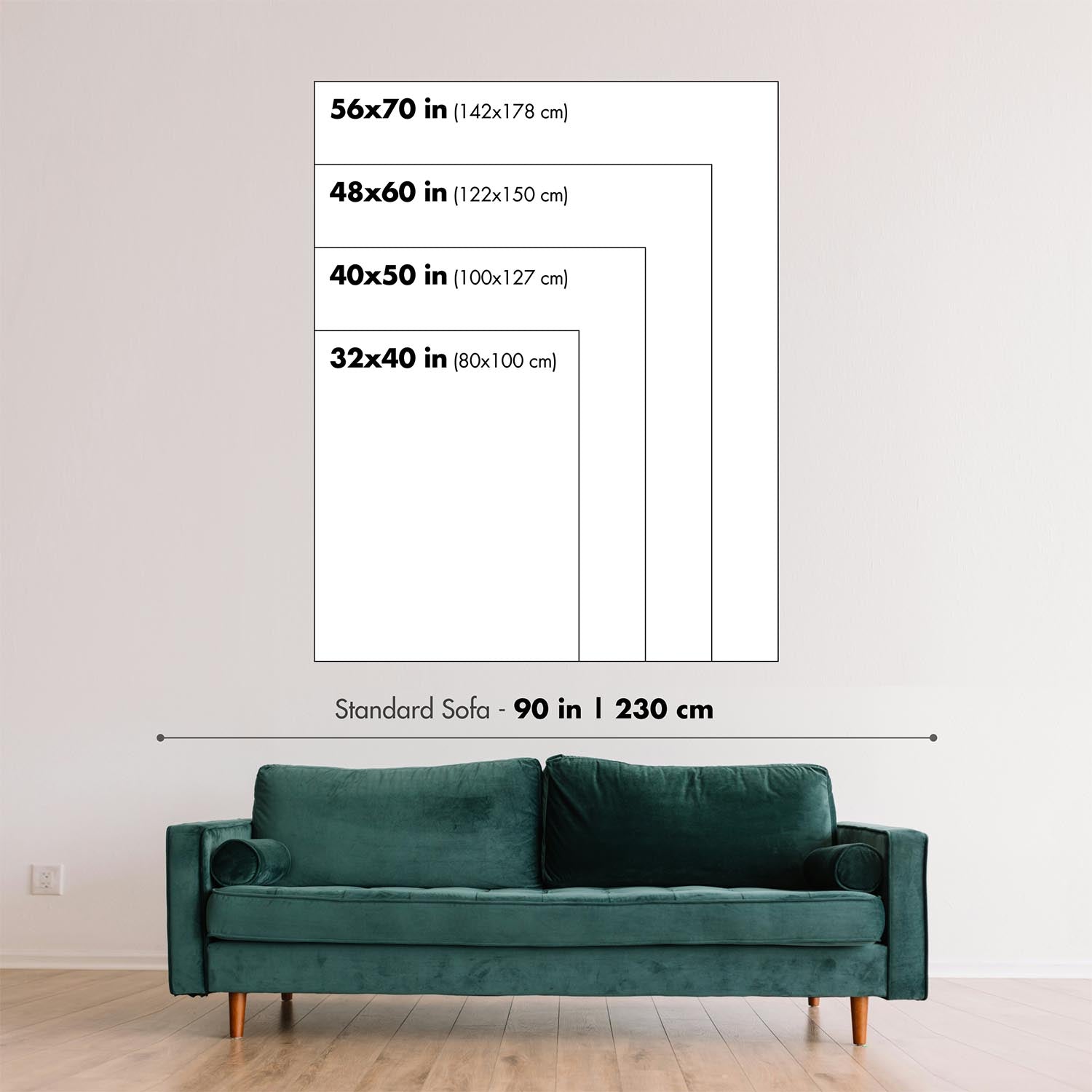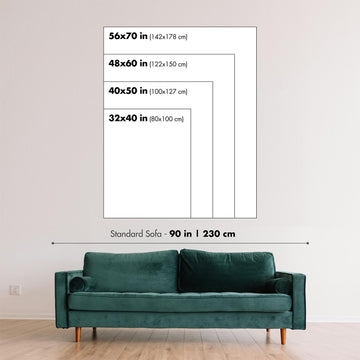- Handmade locally. No import duty or tax
- FREE Delivery by Christmas
- Love it or your money back (90 days)
- Questions? WhatsApp me any time
Own a piece of history
5,000+ 5 star reviews


"Lyonnais," an exquisite pictorial map crafted by the renowned Jacques Liozu in 1951, captures the essence of the Lyonnais province in France with unparalleled artistry and detail. Liozu, celebrated for his thematic and pictorial maps, brings the region to life through vibrant colors and intricate illustrations. His work not only serves as a geographical guide but also as a cultural tapestry, weaving together the rich traditions, historical landmarks, and natural beauty of the area. This map is a testament to Liozu's skill in combining cartography with storytelling, offering a visual journey through the heart of Lyonnais.
The design of the map is a feast for the eyes, with relief shown pictorially to highlight the diverse terrain of the region. Mountains, rivers, and valleys are depicted with a keen eye for detail, creating a sense of depth and realism. The artistic border and decorative elements add a touch of elegance, while the illustrated compass rose and map legend provide functional beauty. Each element on the map is meticulously crafted, reflecting Liozu's dedication to both accuracy and aesthetics.
Lyonnais province is richly represented with its cities and towns, each brought to life through detailed illustrations. From the bustling streets of Lyon to the historic charm of Villefranche-sur-Saône and the industrial heritage of Saint-Étienne, the map offers a glimpse into the diverse urban landscape of the region. Smaller towns like Charlieu, Thizy, and Boën are also featured, each with their unique character and historical significance. This map serves as a visual record of the region's urban development in the mid-20th century.
Beyond the urban centers, the map showcases the natural and cultural landmarks that define Lyonnais. Vineyards and wine production areas are prominently featured, highlighting the region's viticultural heritage. Historic castles, chateaux, and religious buildings are illustrated, offering a window into the architectural splendor of the past. Agricultural scenes, traditional markets, and local crafts are depicted with charm, reflecting the everyday life and customs of the people. This map is not just a geographical representation but a celebration of the region's rich cultural tapestry.
The historical significance of this map lies in its ability to capture a moment in time, preserving the heritage and identity of Lyonnais for future generations. Created in the post-World War II era, it reflects a period of renewed interest in regional identity and cultural heritage in France. Jacques Liozu's "Lyonnais" map is more than a cartographic document; it is a piece of art that tells the story of a region, its people, and its traditions. Owning this map is like holding a piece of history, a timeless reminder of the beauty and richness of Lyonnais.
Cities and towns on this map
- Lyon
- Saint-Étienne
- Villefranche-sur-Saône
- Roanne
- Montbrison
- Charlieu
- Tournon
- Annonay
- Thizy
- Boën
- Neulise
- Oullins
- Vienne
- Rive-de-Gier
- Chazay
- Montluel
- Trévoux
- Châtillon-d'Azergues
- Saint-Just-en-Chevalet
- Feurs
- Saint-Chamond
- L'Arbresle
- Montbrison
Notable Features & Landmarks
- Vineyards and wine production areas
- Historic castles and chateaux
- Traditional clothing and local customs depicted
- Agricultural scenes, including farming and livestock
- Major rivers and water bodies
- Illustrated compass rose
- Depictions of local crafts and industries
- Scenic landscapes and mountainous terrain
- Religious buildings, such as churches and cathedrals
- Representations of famous local personalities
- Traditional markets and trade activities
- Historic monuments and statues
- Local flora and fauna
- Illustrations of local festivals and celebrations
- Artistic border and decorative elements
- Illustrated map legend with symbols and icons
Historical and design context
- Color pictorial map of Lyonnais province, France
- Relief shown pictorially, which means the terrain is represented using illustrations to show elevation and landscape features.
- Date made: 1951
- Mapmaker/Publisher: Jacques Liozu
- Jacques Liozu was known for creating detailed and artistic maps, often with thematic and pictorial elements.
- The map is thematic and pictorial, focusing on the cultural, historical, and geographical aspects of the Lyonnais region.
- It includes illustrations of local traditions, historical landmarks, and agricultural products, reflecting the rich cultural heritage of the area.
- The map primarily shows the Lyonnais province in France.
- The map is designed in a pictorial style with vibrant colors and detailed illustrations.
- It includes artistic representations of people, buildings, and landscapes, providing a visual narrative of the region.
- The map reflects the post-World War II era's interest in regional identity and cultural heritage in France.
- It serves as a historical document showcasing the traditions and landmarks of the Lyonnais region in the mid-20th century.
Please double check the images to make sure that a specific town or place is shown on this map. You can also get in touch and ask us to check the map for you.
This map looks great at every size, but I always recommend going for a larger size if you have space. That way you can easily make out all of the details.
This map looks amazing at sizes all the way up to 70in (180cm). If you are looking for a larger map, please get in touch.
The model in the listing images is holding the 24x36in (60x90cm) version of this map.
The fifth listing image shows an example of my map personalisation service.
If you’re looking for something slightly different, check out my collection of the best old maps to see if something else catches your eye.
Please contact me to check if a certain location, landmark or feature is shown on this map.
This would make a wonderful birthday, Christmas, Father's Day, work leaving, anniversary or housewarming gift for someone from the areas covered by this map.
This map is available as a giclée print on acid free archival matte paper, or you can buy it framed. The frame is a nice, simple black frame that suits most aesthetics. Please get in touch if you'd like a different frame colour or material. My frames are glazed with super-clear museum-grade acrylic (perspex/acrylite), which is significantly less reflective than glass, safer, and will always arrive in perfect condition.
This map is also available as a float framed canvas, sometimes known as a shadow gap framed canvas or canvas floater. The map is printed on artist's cotton canvas and then stretched over a handmade box frame. We then "float" the canvas inside a wooden frame, which is available in a range of colours (black, dark brown, oak, antique gold and white). This is a wonderful way to present a map without glazing in front. See some examples of float framed canvas maps and explore the differences between my different finishes.
For something truly unique, this map is also available in "Unique 3D", our trademarked process that dramatically transforms the map so that it has a wonderful sense of depth. We combine the original map with detailed topography and elevation data, so that mountains and the terrain really "pop". For more info and examples of 3D maps, check my Unique 3D page.
For most orders, delivery time is about 3 working days. Personalised and customised products take longer, as I have to do the personalisation and send it to you for approval, which usually takes 1 or 2 days.
Please note that very large framed orders usually take longer to make and deliver.
If you need your order to arrive by a certain date, please contact me before you order so that we can find the best way of making sure you get your order in time.
I print and frame maps and artwork in 23 countries around the world. This means your order will be made locally, which cuts down on delivery time and ensures that it won't be damaged during delivery. You'll never pay customs or import duty, and we'll put less CO2 into the air.
All of my maps and art prints are well packaged and sent in a rugged tube if unframed, or surrounded by foam if framed.
I try to send out all orders within 1 or 2 days of receiving your order, though some products (like face masks, mugs and tote bags) can take longer to make.
If you select Express Delivery at checkout your order we will prioritise your order and send it out by 1-day courier (Fedex, DHL, UPS, Parcelforce).
Next Day delivery is also available in some countries (US, UK, Singapore, UAE) but please try to order early in the day so that we can get it sent out on time.
My standard frame is a gallery style black ash hardwood frame. It is simple and quite modern looking. My standard frame is around 20mm (0.8in) wide.
I use super-clear acrylic (perspex/acrylite) for the frame glass. It's lighter and safer than glass - and it looks better, as the reflectivity is lower.
Six standard frame colours are available for free (black, dark brown, dark grey, oak, white and antique gold). Custom framing and mounting/matting is available if you're looking for something else.
Most maps, art and illustrations are also available as a framed canvas. We use matte (not shiny) cotton canvas, stretch it over a sustainably sourced box wood frame, and then 'float' the piece within a wood frame. The end result is quite beautiful, and there's no glazing to get in the way.
All frames are provided "ready to hang", with either a string or brackets on the back. Very large frames will have heavy duty hanging plates and/or a mounting baton. If you have any questions, please get in touch.
See some examples of my framed maps and framed canvas maps.
Alternatively, I can also supply old maps and artwork on canvas, foam board, cotton rag and other materials.
If you want to frame your map or artwork yourself, please read my size guide first.
My maps are extremely high quality reproductions of original maps.
I source original, rare maps from libraries, auction houses and private collections around the world, restore them at my London workshop, and then use specialist giclée inks and printers to create beautiful maps that look even better than the original.
My maps are printed on acid-free archival matte (not glossy) paper that feels very high quality and almost like card. In technical terms the paper weight/thickness is 10mil/200gsm. It's perfect for framing.
I print with Epson ultrachrome giclée UV fade resistant pigment inks - some of the best inks you can find.
I can also make maps on canvas, cotton rag and other exotic materials.
Learn more about The Unique Maps Co.
Map personalisation
If you're looking for the perfect anniversary or housewarming gift, I can personalise your map to make it truly unique. For example, I can add a short message, or highlight an important location, or add your family's coat of arms.
The options are almost infinite. Please see my map personalisation page for some wonderful examples of what's possible.
To order a personalised map, select "personalise your map" before adding it to your basket.
Get in touch if you're looking for more complex customisations and personalisations.
Map ageing
I have been asked hundreds of times over the years by customers if they could buy a map that looks even older.
Well, now you can, by selecting Aged before you add a map to your basket.
All the product photos you see on this page show the map in its Original form. This is what the map looks like today.
If you select Aged, I will age your map by hand, using a special and unique process developed through years of studying old maps, talking to researchers to understand the chemistry of aging paper, and of course... lots of practice!
If you're unsure, stick to the Original colour of the map. If you want something a bit darker and older looking, go for Aged.
If you are not happy with your order for any reason, contact me and I'll get it fixed ASAP, free of charge. Please see my returns and refund policy for more information.
I am very confident you will like your restored map or art print. I have been doing this since 1984. I'm a 5-star Etsy seller. I have sold tens of thousands of maps and art prints and have over 5,000 real 5-star reviews. My work has been featured in interior design magazines, on the BBC, and on the walls of dozens of 5-star hotels.
I use a unique process to restore maps and artwork that is massively time consuming and labour intensive. Hunting down the original maps and illustrations can take months. I use state of the art and eye-wateringly expensive technology to scan and restore them. As a result, I guarantee my maps and art prints are a cut above the rest. I stand by my products and will always make sure you're 100% happy with what you receive.
Almost all of my maps and art prints look amazing at large sizes (200cm, 6.5ft+) and I can frame and deliver them to you as well, via special oversized courier. Contact me to discuss your specific needs.
Or try searching for something!















































